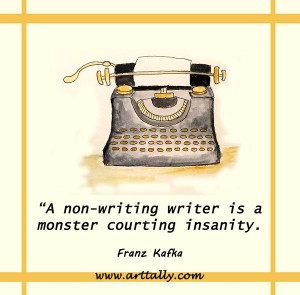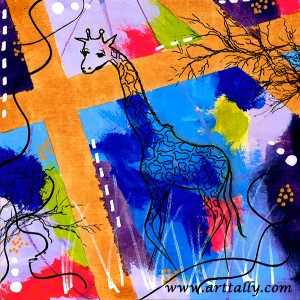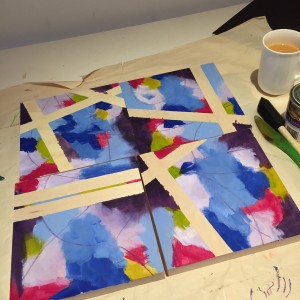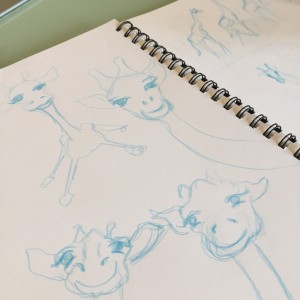Where do you get your ideas?
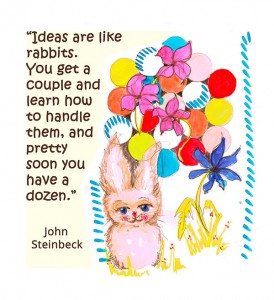 One of the questions people often ask authors is, 'where do you get your ideas?'
One of the questions people often ask authors is, 'where do you get your ideas?'
This was something that used to trouble me. A lot. I worried that I didn't have any ideas. Then before I knew it my problem was not a lack of ideas, but in fact, too many ideas. So many ideas that it is hard to know which idea to focus on and hard to discern a good idea from a bad one. In many ways it feels very much like the same problem.
I think it is because ideas come from the wild and free part of us that the rational, critical self fears so much. As children we spend much more time in that wild free place where ideas abound, all ideas are good and nearly everything seems like fun. We have to learn to tap in to that child like part of ourselves again to find those ideas. When we do they multiply like John Steinbeck promises.
"Ideas are like rabbits. You get a couple and learn how to handle them, and pretty soon you have a dozen." John Steinbeck
Armed with too many ideas, the only way forward is to remain in that same child like state of creative abundance. Free of judgement, open to exploration, and holding off that rational, critical self for long enough to let the best ideas develop enough to reveal themselves.
Intuitive painting, intuitive writing - lessons in surrendering
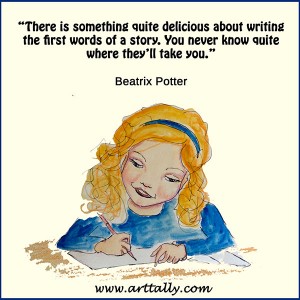 There is something utterly delightful about the idea that you don't have to know exactly where you are going when you start a creative project. The important thing is just to start and trust in the creative process to get you where you need to be. I suppose it is a lesson in surrendering.
There is something utterly delightful about the idea that you don't have to know exactly where you are going when you start a creative project. The important thing is just to start and trust in the creative process to get you where you need to be. I suppose it is a lesson in surrendering.
I'm not sure I realised that you could simply begin a story and let it lead where it may. I did learn that you can paint this way - any one who has had a go at intuitive painting will know exactly what I am talking about.
If you haven't you might want to check out two of my favourite teachers of intuitive painting, Alena Hennessy and Flora Bowley. Even if you don't fancy painting yourself it is a fascinating thing to watch Flora Bowley's paintings emerge - you can see her in action here. And she explains her whole process in her book Brave Intuitive Painting. Love it.
If you think you might be a writer heed this warning
If you suspect that you might be a writer, then there is one thing you must do.
WRITE.
Grab a notepad, a laptop or the back of that shopping list stuffed down the bottom of your handbag. Unless she is given a voice that frustrated writer trapped inside you will drive you (and everyone around you) crazy.
Figure out what is stopping you and find a way past it.
Heed this warning from Frank Kafka:
"A non-writing writer is a monster courting insanity."
The best way to learn to write is to write
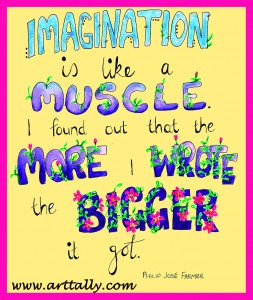 I have come to the conclusion that writing, like a lot of things, is something you really have to learn by doing. In the beginning it is frustrating. Progress is slow. Probably occasionally mortifying. Okay... often mortifying.
I have come to the conclusion that writing, like a lot of things, is something you really have to learn by doing. In the beginning it is frustrating. Progress is slow. Probably occasionally mortifying. Okay... often mortifying.
Lots of books have been written about writing and I suspect most new writers have read many of them. But when you start writing it doesn't feel like any of that preparation helped much. But if you persist a marvelous thing happens. All those abstract concepts you read about, like point of view, story arc, and the rule of 'show don't tell', suddenly make a whole lot more sense. I'm not sure you can really get to grips with any of it until you are actually trying to apply it. The best way to learn to write is to write.
One of the great things about NaNoWriMo is that you don't have time to get stuck. I know very well that if I had been writing this without the clock ticking down and that graph of my word count progress constantly accusing me I would have got myself stuck trying to solve one of these technical problems. But during NaNoWriMo you just have to make the best of it, perhaps make a note to come back to it later and move on. In doing that you put in the practice hours that are the only way to get better at writing. Sure you will have to come back to all those sticking points at a later date, but it is better to press on in the meantime than to simply draw to a grinding halt.
I am surprised by how often things end up resolving themselves. Perhaps it is those hamsters on that wheel inside my head that manage to nut it all out while I am drawing, sleeping or doing those endless loads of washing a family is capable of conjuring up daily. Either way, it seems if you leave those mole hills alone for a time, they get to remain mole hills instead of turning into the mountains that might completely block your path. Who knew?
Even one of the things that worried me the most - that I didn't have the imagination to come up with an entire story for a novel seems to be getting easier. Now that for me is an enormous relief. I am happy to report that I (so far) concur with Philip Jose Farmer who says,
"Imagination is a muscle. I found out that the more I used it, the bigger it got."
A series of illustrated quotes on writing
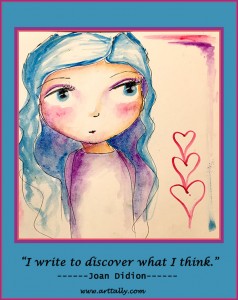 Did I mention my series for the month? I expect that in all my excitement to get writing a novel (!) I might have neglected that. I know you may have probably already figured it out, but this month I am doing a series of illustrated quotes on writing. Its a good series for me because I love quotations and it is giving me a chance to use Photoshop a bit more.
Did I mention my series for the month? I expect that in all my excitement to get writing a novel (!) I might have neglected that. I know you may have probably already figured it out, but this month I am doing a series of illustrated quotes on writing. Its a good series for me because I love quotations and it is giving me a chance to use Photoshop a bit more.
Have you tried Photoshop? I find it as frustrating as it is amazing. It does so many awesome things but I often find trying to do the simplest task can be infuriatingly difficult. My first in this series I did with Canva in the end. If Photoshop is frustrating you, or you don't have access to it, I highly recommend giving Canva a go. Quite simple and lots of fun.
After the first in this series On Writing, I have been trying to be strict with myself about using Photoshop. Like everything, it is easier every day. Here is the link to the whole series on one page.
A new adventure called Nanowrimo
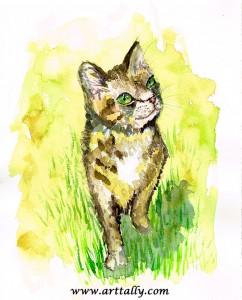 Cat no 10 in my watercolour cat series for this month is a happy little chap out exploring the world.
Cat no 10 in my watercolour cat series for this month is a happy little chap out exploring the world.
I can relate - I am exploring too. In fact I'm off on a bit of an exciting adventure next month. I say next month in a casual sort of way, but I realise that is only a week or two away. And I say 'off' like I am going somewhere but there is no travelling required. I decided to sign up for Nanowrimo. Have you heard of it?
Nanowrimo is the National Novel Writing Month. It happens every November and it is totally free to join. The deal is that you sign up to the website and then commit to writing 1667 words every day for the month of November. If you manage that, you have a 50 000 word draft of a novel by 1 December. Now doesn't that sound fun?
I always wanted to write some sort of fiction but I worried because I never managed to get a working plot idea. In fact, that is exactly how I found Nanowrimo in the first place. My solution to everything is to do a bit of research (hazard of my former occupation). My research led me to a book written by the founder of Nanowrimo, called No Plot? No Problem!
The author, Chris Baty, describes it as a "low-stress, high-velocity guide to writing a novel in 30 days".
Low-stress, Chris?... hmm... we will see.
Worst case scenario I will just be doing extra drawing and painting to calm myself I suppose. I have already had to do a bit of that, since I only have Chris's word so far, that embarking on novel writing without a plan is not a problem. Feels like flying blind to be honest, however to me, that still seems preferable to tediously cranking out a plot beforehand. Frankly, I feel quite relieved that someone has give me permission to attempt it.
I'm mad for a creative challenge (as you may have already gathered) and this one definitely has my name written all over it. How about you? Will you join me?
Go on... you know you want to. Chris's book might tempt you - it is very encouraging...
Learning to draw is good for you
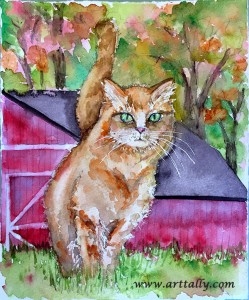 This is Redford. He is my fourth project in the Crazy Cats class with Miriam Schulman.
This is Redford. He is my fourth project in the Crazy Cats class with Miriam Schulman.
This project felt a little more daunting than the others, somehow. It felt like it required a lot more drawing. I procrastinated a fair bit before I started this painting, and I think it was mostly because of the drawing aspect. That's the thing with watercolour, isn't it? Most of the time you really need to be able to start with a decent sketch, so if you are uncomfortable drawing it makes watercolour painting really hard.
Funnily enough, the part I enjoyed the most with this painting was the drawing. Having to spend a little more time on the sketch gave me a chance to remember that I really love the process of drawing. It is one of the most relaxing creative pursuits I can think of. If you can stop worrying about how it is going to turn out, and surrender to the process of careful observation and mark making, time slips by. You can escape the world for a moment and just be in the present, enjoying the tactile experience of marking textured paper with graphite. Taking the time to appreciate lights and shadows, shapes and lines.
And then as an added bonus when you are done you get to splash colour and water all over it. Can't think of a better way to pass an hour or two...
The art of procrastination
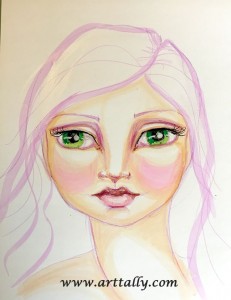 Some days you can spend hours at the computer, busily working away. Click, click, type, type. No end of activity. Sounds productive. And then eventually you realise that it is because you decided you desperately needed to take a free online typing test to check your typing speed. Because this of course is of greater or at least equal importance to working on that post you committed to write, or all those other tasks on the list.
Some days you can spend hours at the computer, busily working away. Click, click, type, type. No end of activity. Sounds productive. And then eventually you realise that it is because you decided you desperately needed to take a free online typing test to check your typing speed. Because this of course is of greater or at least equal importance to working on that post you committed to write, or all those other tasks on the list.
There are many battles to be fought in the creative process. It is practice for everyday life. There is a complete gauntlet to be run each time you try to indulge your creative urges. If the inner critic doesn't thwart you, procrastination might.
Its a sneaky beast, this Procrastination. Sometimes it is in disguise. It can cloak itself in the guise of research. Maybe planning. Getting organised. These things are all very valid, potential productivity enhancing activities. However, they are ancillary, support activities, not the main event. Important? Yes. Helpful? Yes. But if they are standing between you and the task at hand, efficient they are not.
If you feel busy then you may not realise that you are procrastinating. Procrastinating, sounds like you are not doing much. Therefore if you are actively engaged in furious activity you can't be procrastinating.
Procrastination is fear of beginning. Researching, planning and getting organised are all helpful activities that will ensure that your project gets off to a good start. But they are the preliminaries. This preliminary phase needs to be curtailed. Preparation is always key to setting up your project for success. Eventually you have to ask yourself if you are just procrastinating. There is never 'enough' research. You have to just start, even if you don't feel ready.
The bible on getting things done is called Getting Things Done by David Allen. But if your procrastination time budget does not extend to reading a whole book here are 29 lifehacks for procrastination instead.
How to manage your inner critic
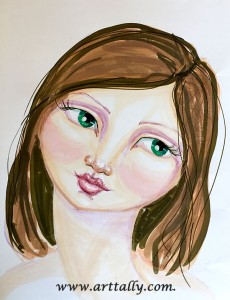 I was supposed to post Face no 12... this one above, yesterday. I drew her. I was not pleased. I decided to begin again. Having completed Face no 13, I concluded she was worse than Face no 12. Ah, the inner critic.
I was supposed to post Face no 12... this one above, yesterday. I drew her. I was not pleased. I decided to begin again. Having completed Face no 13, I concluded she was worse than Face no 12. Ah, the inner critic.
When the inner critic pipes up with her judgement, it is easy to feel paralysed. To just stop seems an easier, and far more sensible solution than to continue.
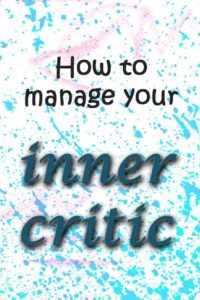 The inner critic is a defense mechanism. Her aim is to reduce our risk. To prevent us from being judged by others, and possibly hurt in the process. However, despite these good intentions, sometimes she succeeds only in strangling the muse, and any motivation to act on any creative urge.
The inner critic is a defense mechanism. Her aim is to reduce our risk. To prevent us from being judged by others, and possibly hurt in the process. However, despite these good intentions, sometimes she succeeds only in strangling the muse, and any motivation to act on any creative urge.
Learning how to manage your inner critic stems from that awareness. Knowing that it is a protective mechanism we can acknowledge and appreciate the self care intention. From this much gentler place we can assess more rationally the seriousness of the risk perceived by the inner critic.
To make that evaluation you need to return to your 'why'. Why are you creating? There are a host of valid reasons. In fact, I don't think I can think of an invalid one. But the mere fact that you began the creation process suggests that it is a necessary self expression. We all have the right to express ourselves, regardless of our talent or ability. To create just for the sake of creating. As the creator, your job is to create, not to judge the creation.
Create because you feel the inclination to create.
Create because it gives you joy.
Create for the delight of the process.
Let the output of your creative process be whatever it will be. Inevitably, with practice you can only become better. But if you let the inner critic thwart your process in the early stages, you will never get to see that for yourself.
How to make a big goal manageable with tiny steps
A couple of months ago I resolved to create something every day and post it here. I have been pretty good at keeping this up but last week I seemed to be wavering.
I have also been doing the 100 day project with Elle Luna at The Great Discontent. I took up the additional challenge to post a daily 10 minute journal every single day for 100 days. Last week I completed that 100 days. Yay! (You can check it out on Instagram by the way).
Completing a challenge like this is rather motivating. It helped me remember how important it is to take tiny steps towards your goal. As the Chinese proverb says,
"The man who removes a mountain begins by carrying away small stones."
This is really the only way to take a great big goal, and turn it into something manageable. Never underestimate the cumulative power of small repeated actions. The big picture goal can be overwhelming. Choices too, can be overwhelming. So devising a plan of tiny steps is a way of taking a large abstract goal or objective and making it into a series of executable actions without the distraction of having to decide what to do next. For me, the overarching objective of learning to draw and paint better is now simply a question of turning up every day and making a painting of a predetermined subject. Much more achievable.
My main objective is to be creative every day, and to learn to draw and paint. Sometimes the writing part of my posts is a bit of a distraction. The main purpose is to keep drawing. And I am rather pleased with my subject choice for this month. It turns out that drawing curvy exotic teapots and then decorating them is a surprisingly relaxing pastime... who knew!
"Success is the sum of small efforts, repeated day in and day out." - Robert Collier
Explore more of the Tea Time series posts here
Learn to draw for fun - no pressure, no expectations
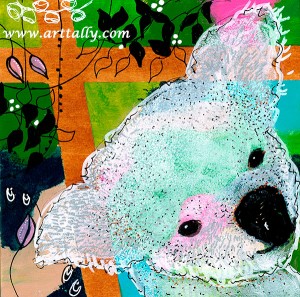 I believe anyone can learn to draw. Drawing is so good for us. It teaches us to be mindful, observant. It helps us slow down and unwind. Its also a really fun thing to do.
I believe anyone can learn to draw. Drawing is so good for us. It teaches us to be mindful, observant. It helps us slow down and unwind. Its also a really fun thing to do.
Although maybe not so much when you are first starting out. The problem with learning new things is that we often fail to give ourselves permission to be beginners. Being bad at something doesn't feel excellent. But being bad at something is the first step towards being good at it.
I don't think you need to actually be good at it to reap some of the wellness benefits. Doing something with your hands is a good way to come back to the present. To spend some time doodling is a helpful way to switch off, perhaps after work, or if you have trouble falling asleep.
Drawing is a skill anyone can learn. There are techniques and rules that anyone can learn and with enough practice become proficient. Its a question of how many hours you are prepared to put in.
Those early hours are the tough ones. Like learning anything new, the first attempts can be almost painful - just think about what it's like to have your first few lessons with a new musical instrument! Even learning to drive has similar problems - you need to know so much at once to be able to execute the task.
However, the internet provides us adult learners with a rather marvelous opportunity. You can learn almost anything in the privacy of your own home and often enough, for little or no cost. Thank you, You Tube!
Drawing is no exception. I reckon the best way to start to learn to draw is to dig out that old bic from the bottom of your handbag, grab a scrap of paper that was already on its way to the recycling bin and have a doodle. Why not?
Don’t agonise over which supplies. Don’t go and purchase a fancy new sketchbook. These things ramp up the expectations you have of yourself and turn something that could be just a bit of relaxing fun into a Big Thing.
Need some inspiration? A bit of helpful instruction? Your smartphone is close to hand, I bet…. Many lovely teachers are just waiting for you. It was tricky to narrow down the list but here are three of my fave You Tube drawing teachers:
1. Learn to draw with Alphonso Dunn
Alphonso provides weekly videos on how to draw everything. No really, that is his tagline. I would suggest heading to the playlists and going for something like the ‘how to draw everything else under the sun’ playlist. There is a drawing fundamentals playlist. My suggestion is not to start there. Time for that later. This is just supposed to be fun. It's not school. Choose a short video - 5 minutes or so. How to draw an asteroid perhaps? A raindrop?
2. Learn to draw with Art a la Carte
Art a la Carte also provides weekly art videos for all ages and skills. You might find more of the cutesy stuff over here… cartoon kitty cats for example. Fun!
3. Learn to draw with Fine art tips
Sometimes when I feel a bit tired of drawing (what? Tired of drawing??) I find almost as much enjoyment in watching someone else draw. There is something soothing and absorbing about watching someone skillfully pull a three dimensional image out of a flat empty page. I love watching the image gradually emerge. Oh, and the sexy accent doesn’t hurt….
So what are you waiting for? Let's draw something!
Use your artist's eyes to find a little more daily happiness
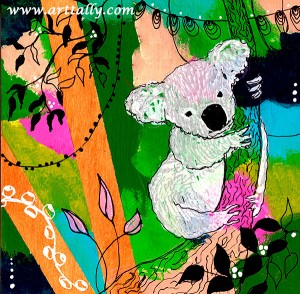 It is a privilege to be able to see the world through artist's eyes. The same privilege as it is to see the world through the eyes of a child. Have you ever taken a walk with a three year old? In 100m there will be a surprising amount of fascinating diversions. Every ant, shadow and unusual shaped leaf can absorb and entertain a child. We probably don’t even notice these things.
It is a privilege to be able to see the world through artist's eyes. The same privilege as it is to see the world through the eyes of a child. Have you ever taken a walk with a three year old? In 100m there will be a surprising amount of fascinating diversions. Every ant, shadow and unusual shaped leaf can absorb and entertain a child. We probably don’t even notice these things.
But if you are open to it, as we all are as children, there is awe and beauty in every dewdrop balanced on a leaf tip, the shafts of new light through the trees, the contrast of red and gold autumnal leaves against a perfect blue sky.
Finding the joy in these things is the path to a little more happiness in every day. Far more so than in the ‘big’ things, like winning the lottery or getting that promotion.
If you want to reawaken that child-like awe, the easiest way to do it so to draw something. You don't need to draw well, you just need to practice using your artist's eyes. And yes, we do all have artist's eyes, whether you believe it or not.
Drawing is 90% looking and 10% drawing. It requires the abandonment of judgement and preconception. You know that the your teacup is round but right now, from this angle, the rim actually looks like an oval. You know mountains don’t really have blue grass but right now those mountains do indeed look blue .
Being required to see things just as they appear rather than how you think they are supposed to be, forces you to really notice your world. If you draw and paint regularly you start to see the world in all its glory again. The shadow pattern made on the carpet by the light from the window can somehow enthrall. The arrangement of a throw, a pillow and book tossed on your chair in the living room delights. Maybe it's the composition. Maybe it is the marriage of colours - quite coincidental but even more lovely for it. These small things are enough to lift your spirits just that little bit.
In a world that bombards us with a constant stream of usually less than positive news events, the little dose of happy to be found in every part of our environment is just the counterbalance we need.
What will you try today? ...consider Picasso's advice...
"God is really only another artist. He invented the giraffe, the elephant and the cat. He has no real style, He just goes on trying other things." Pablo Picasso.
Excellent point, Picasso.
Let's let go of norm and expectation and try new, different things.
Play. Experiment.
This is good advice if you are an artist worrying about finding your style.
But really, it is good advice for all of us, in our daily lives. Life presents us with a veritable smorgasbord of opportunities. It would be a shame to miss out by not trying whatever we can. Sticking only to what we know deprives us of the chance to discover new joys.
What will you try today?
Count on a giraffe to brighten your day
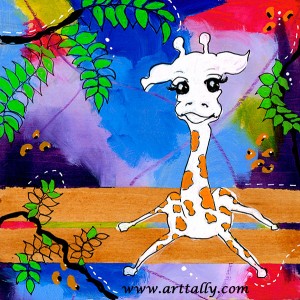 I am painting giraffes this week, and a jolly cheery thing it is to do.
I am painting giraffes this week, and a jolly cheery thing it is to do.
I started out with bright colourful backgrounds I loved .... (and a cup of tea)
And then did some sketches of various giraffes...
and then found that I was quite paralysed when it came to putting the giraffes on the backgrounds. It is hard when you have something you like in the background because you can't help but worry about messing it up. And in a sketch, all is forgiven. Lines that are not quite right seem okay in the sketch, but when you start painting the sketch they start to scream at you.
However, I bravely committed. And I am now resolving to paint more giraffes because they are such a remarkable animal. A most unusual beast. I have learned all sorts of things about them (no fear.... there is more on that in another post...) but today there is something else I want to share.
There is a most wonderful story about a giraffe. It is a children's story... my very favourite kind of story. Like all the best children's stories it has a message for us all. It is a tale about celebrating your uniqueness, forging your own path, knowing you can do anything you put your mind to by finding your own special way.
The book is called Giraffes Can't Dance by Giles Andreae. There are also narrated videos of the picture book available on You Tube. Happily I watched quite a few of them today.... all in the name of research. I think this one is my favourite. Check it out - it's very short, and sure to brighten your day (whatever age you may be).... here is the link.
The importance of true grit
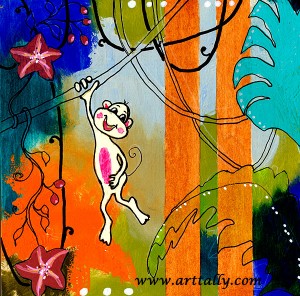 If I am honest, I have reached a bit of a lull in my quest to willingly post my daily creations. But I think this is an inevitable part of a creative process. The initial enthusiasm that comes with a new idea gets you going. Then that steam runs out and it becomes a question of persistence. To keep on placing one foot in front of the other. Now is the time to understand the importance of true grit.
If I am honest, I have reached a bit of a lull in my quest to willingly post my daily creations. But I think this is an inevitable part of a creative process. The initial enthusiasm that comes with a new idea gets you going. Then that steam runs out and it becomes a question of persistence. To keep on placing one foot in front of the other. Now is the time to understand the importance of true grit.
Jerry Seinfeld talks about marking a cross on the calendar every day that he does some writing. The point is to make a chain of crosses. Not to write something brilliant. But simply to show up and write. Every day.
So I feel that that is where I am right now. Making the most of the opportunity to demonstrate that I have some grit. I really don't like that word, somehow. But persistence (grit) has been shown to be a key predictor of success. (There is a TED talk by Angela Lee Duckworth that explains the importance of grit, if you happen to be in the mood for a vid!)
To be persistent you have to be okay with imperfection, with failure even. Persistence is continuing in spite of setbacks. A setback can just be a call to your creativity, awakening your problem solving equipment in order to find a way to move forward.
“The most important thing about art is to work. Nothing else matters except sitting down every day and trying.” ― Steven Pressfield
Persistence is probably what the 'p' stands for in professional. An amateur stops when things become hard, or when enthusiasm and inspiration wane. A professional continues doggedly on, whether they feel like it or not. Writers know all about this. For example,
“I write only when inspiration strikes. Fortunately it strikes every morning at nine o'clock sharp.” ― W. Somerset Maugham
The effort of persisting is very worthwhile, though. It is helpful to keep a mental note of past successes achieved through perseverance. Recalling these successes is a great encouragement when your persistence is being tested again. So I have seen for myself that continual practice, in small but steady ways really does build your skills. I am choosing to see this as an opportunity to rack up another mental note of successful perseverance in the memory banks. We will mark the occasion with this whimsical monkey swinging through mixed media vines on a wooden panel.
By the way, there is a test you can do to determine how 'gritty' you actually are. So if you love a personality test or two (let's be honest... who doesn't?) you can try this one...
Whimsy is fun
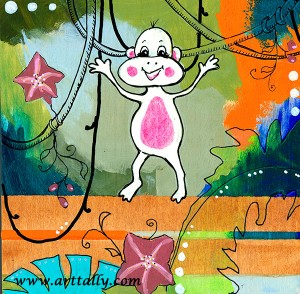 The next set of animal panels for this month feature this crazy little monkey.
The next set of animal panels for this month feature this crazy little monkey.
Apparently I can't stay away from whimsy. Whimsy is fun, and the reason I started painting in the first place was to have fun. Life is serious enough. So for me, painting is about a return to the simplicity of childhood. If it is cute and silly and colourful, I love it.
What better way is there to add a bit of fun to every day?
"Today was good. Today was fun. Tomorrow is another one." Dr. Seuss
Amazing facts about the owl
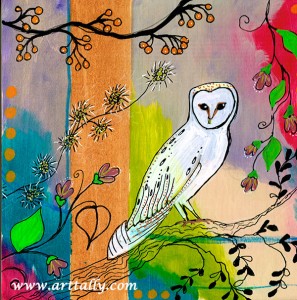 Whenever I choose something to draw, one of the things I love most is how studying its form in order to capture a likeness makes your curiosity about the subject grow. It is one of the things I love most about art. It can take you away from your everyday worries for a little to ponder something completely different. To contemplate and appreciate the world around us.
Whenever I choose something to draw, one of the things I love most is how studying its form in order to capture a likeness makes your curiosity about the subject grow. It is one of the things I love most about art. It can take you away from your everyday worries for a little to ponder something completely different. To contemplate and appreciate the world around us.
I chose owls for this first set in the June series because I think there is something a little bit special about them. Quiet, graceful, knowing. They are really not like any other bird.
We probably think of them as birds of prey, grouping them in our minds with hawks and eagles. But there is a school of thought in the taxonomy of these birds that their closest relatives are in fact hummingbirds and kingfishers. Hawks and eagles are diurnal hunters and therefore considered a little more primitive, akin to the cranes, herons, and other prehistoric-looking birds. Owls are nocturnal hunters, cleverly avoiding competition by hunting in opposite hours to the birds of prey.
One of the owl's most distinguishing features is its eyes. Those large round eyes are in fact completely immobile. They are not 'balls' as such but are shaped more like tubes. Unlike other birds, owl eyes are on the front of the head rather than the side, giving them the more human quality of binocular vision.
Of course, having totally immobile eyes, no matter how captivating they may be, is something of a limitation. The owl compensates by being able to rotate its head 270 degrees - not full circle as we may have liked to believe.
Being able to rotate your head in an almost complete circle does mean that you will be asking rather a lot of your neck. The owl neck has fourteen vertebrae, twice the number found in other birds. These vertebrae facilitate the impressive range of motion. Such a range of motion however, creates its own set of problems.
Twisting at the neck so dramatically impacts the blood circulation to the brain. The owl has some rather amazing systems to deal with this issue. For example it has developed alternative blood vessel routing and air-cushioned vessel casings to prevent rupture and stroke during violent head motion. And when neck movement cuts off circulation, the owl has special blood-pooling systems that collect blood to power their brains and eyes.
What a remarkable creature the owl is.
If you would like to know more about the amazing owl here are some good places to start:
- 10 Awesome facts about owls
- Video: True facts about the owl
- Comprehensive information on owls from Bioexpedition.com
Creative courage
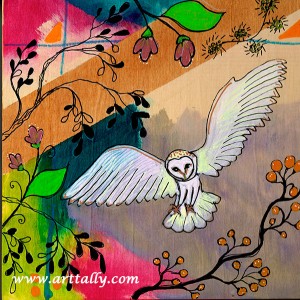 One of the things that I never really understood before was just how much courage creativity takes.
One of the things that I never really understood before was just how much courage creativity takes.
I have to admit that I spent an extraordinarily long time 'arranging my workspace' when I started this painting. I kept telling myself - its just paint and wood.... nothing to fear, surely?
And once you manage to get over that initial resistance its so much fun. I love colour. Splashing it about for the background just makes me happy. And I love my acrylic markers. I had some loud music going at first (I usually do... Only when that album was finished and I had silence did I notice the delightful scratch of the marker tip on the wood panel. Inexplicably soothing.
Indulging your creative side is a fascinating journey of self discovery. I don't think there are any solutions to finding creative bravery really, other than to feel the fear and do it anyway. That is what bravery is anyway, isnt it? It is not the absence of fear but the taking of action in spite of the fear.
"It takes a lot of courage to show your dreams to someone else." - Erma Bombeck
"Creativity requires the courage to let go of certainties." - Erich Fromm
"Creativity comes from trust. Trust your instincts." - Rita Mae Brown
How to set up your new project for success
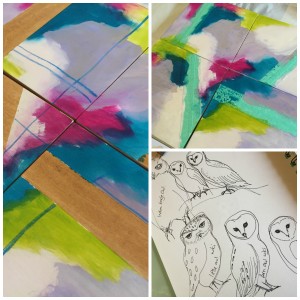 I start a new project every month. It's very exciting, but also a little scary. This month I am painting a series of square mixed media panels that feature animals. Last month it was flower faces on paper (see the finished gallery here!)
I start a new project every month. It's very exciting, but also a little scary. This month I am painting a series of square mixed media panels that feature animals. Last month it was flower faces on paper (see the finished gallery here!)
On the first working day of each month I get a fresh start. Here are five ideas to consider so that you set up your new project for success.
1.Start with why.
Try and articulate for yourself exactly why your are doing this project. Being clear about your purpose will enable you to evaluate your progress more fairly. It will be your guide post as you need to make decisions during the project. Simon Sinek explains that getting to the heart of why we do what we do is to tap into our own infinite source of inspiration and motivation.
2. The honeymoon phase
Enjoy the initial burst of enthusiasm that heralds the start of a new project. Celebrate it. Know that it is a part of the energy cycle of the project and it wont last. Anticipating this means you can try to avoid being disappointed that you didn't maintain your momentum or beat yourself up about it when the enthusiasm wanes. But make the most of the initial excitement - it is the impetus that gets you started.
3. Identify your requirements and resources.
Usually we are pretty good at figuring out what we are going to require in terms of materials for a project. But there is more to consider in preparing your project for success. Don't overlook the project's requirements in terms of time and support. Be realistic about how much time you will need to put in as well as any time requirements for other team members. Consider the resources you have available. Access to a mentor for example, can be an important resource, as can access to other additional help such as substitute/alternate team members or alternate suppliers as a back up in case of emergency.
4. Baby steps
How do you eat an elephant? One bite at a time. Even the most daunting task can be made easier to approach by breaking it down into small achievable steps. Once you have an idea of the steps, you can measure your progress by measuring the process rather than results. Your chances of success are far greater if you can focus on your systems rather than just your ultimate goal.
5. Give yourself a buffer.
Nothing goes according to plan. Where would the fun be in that anyway? But when things go awry it can knock you off schedule. Be kind to yourself and build in a bit of extra time in your schedule to deal with the unforeseen.
Art and the importance of play
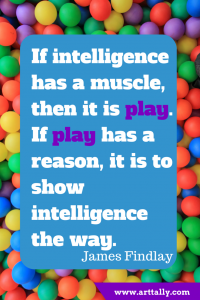 The importance of play
The importance of play
Quite a few years ago I was in the middle of a very long study programme. I was working. I had two small children. Every minute of my day seemed scripted. It also seemed to be mostly for satisfying other people’s needs. Then, seemingly out of the blue, I got it into my head that I wanted to learn the piano. I had never played an instrument before. I didn't have a piano. And I was very busy doing other ‘important’ things. But for some reason I heeded the call. I hired a digital piano, bought myself an online piano course and started to learn.
I’m so glad I did - despite that little voice in my head that kept saying What are you doing? This is so silly… Isn't it a waste of money? You really don't have time for these needless things…
But that was just the point. I needed exactly that. Something needless. Something just for me, that didn't really matter. I could be good at it or bad at it. Do it often or seldom. It was just for fun. I wanted to play.
What is play?
In his TED talk, Dr Stuart Brown used the word needless to explain what play is. He describes play as an activity that is more about process than outcome, that is done purely for enjoyment. He also says the opposite of play is depression. Play is vital.
Play is not just something children do in preparation for adulthood but a biological process necessary in all phases of life. Neuroscientists have worked out that play lights up our brains - there is even an entire scholarly journal dedicated to it, The American Journal of Play!
We all need to make time in each day for a bit of fun - a chance to play, even adults. In fact, I want to say, especially adults. Everyone agrees fun and play is important for children but we tend to overlook these things in adulthood. It was in watching my small child drawing that I realised grown ups need to play too - in fact that is what started my art journey.
Art is play
For me, art is play. According to the National Institute for Play, there are seven types of play:
- attunement play
- body play and movement
- object play
- social play
- imaginative and pretend play
- story telling and narrative play
- creative play.
Making art encompasses several of these. Artists work with their hands, manipulating objects such as pens, brushes, clay, paper. Working with our hands (object play) has been identified as an important way in which our brains develop problem solving abilities
Making art is a chance to escape into a fantasy world for a brief time, satisfying our need for self expression and developing the neural pathways required for innovative thinking (creative play).
Anyone who has every kept an art journal will be in no doubt that this process helps us to explain, describe and make sense of our world. This is what story-telling and narrative play is all about.
Daily play
Dr Dan Seigel recommends dividing our time between seven essential mental activities every day, for optimum health:
- sleep time
- physical time
- focus time
- down time
- time in
- play time
- connecting time
These things make up what he describes as our healthy daily platter - the mental equivalent of healthy food plate. Alongside things like sleeping, working and exercising we should be consciously setting aside play time.
How funny it is that once we become adults we need to be told to go and have some fun every day…
“Play is the gateway to vitality.
By its nature it is uniquely and intrinsically rewarding. It generates optimism, seeks out novelty, makes perseverance fun, leads to mastery, gives the immune system a bounce, fosters empathy and promotes a sense of belonging and community.” National Institute For Play
So what are you going to play at today?

